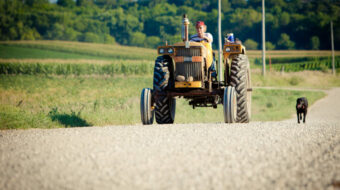Los Angeles County’s largest-ever brush fire, the Station Fire – raging since Aug. 26 in the Angeles National Forest 20 miles north of Los Angeles – was reported 42 percent contained Sept. 4 after ripping through nearly 150,000 acres. Fire officials say the fire may not be fully contained until mid-September. Some have speculated that a flare-up of Santa Ana winds, absent so far, could fan the flames again.
Two firefighters, members of California Professional Firefighters Local 1014, have died in the blaze. Los Angeles County Fire Captain Tedmund Hall, 47, and Firefighter Specialist Arnaldo Quinones, 34, who died when their truck plunged over an embankment, will be remembered at a Sept. 12 memorial in Dodger Stadium. Several other firefighters have been injured, or have been treated for exposure to hazardous materials.
After reportedly finding incendiary material near an area identified as the fire’s starting point, U.S. Forest Service officials are conducting an arson investigation.
In the wake of the Station Fire and several other wildfires in central and southern California, environmentalists are warning that larger and more frequent wildfires can be expected as global warming intensifies. They point out that mountain snowpack providing much of California’s water is thinner and melts sooner, while warmer winters encourage the spread of the mountain pine beetle, which kills trees, turning them into tinder.
In a study published in the Journal of Geophysical Research, Harvard University atmospheric scientists say forest areas consumed by wildfires could soar by more than 50 percent by mid-century, with rising temperatures the main factor.
The number of new homes built in fire-prone areas is also a factor – more than half California’s new housing has been built in severe fire zones. Communities in the area of the Station Fire largely consist of second homes and vacation homes.
“We do know that in places like the Rocky Mountains, fire seasons have already grown in length and severity. These catastrophic wild fires are something we can expect to see more and more of, with climate change,” San Francisco-based Sierra Club spokesperson Kristina Johnson said in a telephone interview.
Fire will become a bigger risk for communities as more people move into “wild land/urban interface areas,” Johnson said.
Asked about allegations that not enough brush had been cleared from the area before the Station Fire broke out, Johnson said the Bush administration “was using fire prevention as an excuse to open the back country to logging” instead of conducting other activities like clearing brush.
“We know that [the Obama] administration’s priorities are different and we are optimistic this administration is going to put communities and people first,” she said.
The Station Fire threatened some 10,000 homes, actually consuming over 60. Thousands of area residents were ordered to evacuate their homes. As of Sept. 4, the United Way’s Labor Community Services agency said 33 people were still housed in its shelters. The Red Cross earlier said it had provided shelter to some 474 people across southern California, including those involved with other wildfires. The Red Cross and Salvation Army were also providing food and other aid.
Among structures threatened by the Station Fire at its height was the historic Mount Wilson Observatory, where among others, astrophysicist Edwin Hubble worked in the 1920s, discovering that the universe is made up of many galaxies and that it is expanding at an accelerating rate. The observatory continues its cutting-edge research today.
Also threatened were mountaintop towers providing cell phone service and radio/TV service for parts of Los Angeles and surrounding suburbs.
Other wildfires now burning in California include the Oak Glen fire which consumed over 1,000 acres in San Bernardino County, the Big Meadow fire in Yosemite National Park – a “controlled burn” that got out of hand, and a grassfire that burned 50 homes near Auburn, in central California.
mbechtel@pww.org










